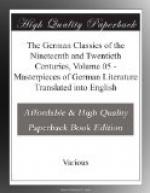Plastic Art, therefore, evidently stands as a uniting link between the soul and Nature, and can be apprehended only in the living centre of both. Indeed, since Plastic Art has its relation to the soul in common with every other art, and particularly with Poetry, that by which it is connected with Nature, and, like Nature, a productive force, remains as its sole peculiarity; so that to this alone can a theory relate which shall be satisfactory to the understanding, and helpful and profitable to Art itself.
We hope, therefore, in considering Plastic Art in relation to its true prototype and original source, Nature, to be able to contribute something new to its theory—to give some additional exactness or clearness to the conceptions of it; but, above all, to set forth the coherence of the whole structure of Art in the light of a higher necessity.
[Illustration: FRIEDRICH WILHELM JOSEPH VON SCHELLING Carl Begas]
But has not Science always recognized this relation? Has not indeed every theory of modern times taken its departure from this very position, that Art should be the imitator of Nature? Such has indeed been the case. But what should this broad general proposition profit the artist, when the notion of Nature is of such various interpretation, and when there are almost as many differing views of it as there are various modes of life? Thus, to one, Nature is nothing more than the lifeless aggregate of an indeterminable crowd of objects, or the space in which, as in a vessel, he imagines things placed; to another, only the soil from which he draws his nourishment and support; to the inspired seeker alone, the holy, ever-creative original energy of the world, which generates and busily evolves all things out of itself.
The proposition would indeed have a high significance, if it taught Art to emulate this creative force; but the sense in which it was meant can scarcely be doubtful to one acquainted with the universal condition of Science at the time when it was first brought forward. Singular enough that the very persons who denied all life to Nature should set it up for imitation in Art! To them might be applied the words of a profound writer:[5] “Your lying philosophy has put Nature out of the way; and why do you call upon us to imitate her? Is it that you may renew the pleasure by perpetrating the same violence on the disciples of Nature?”
Nature was to them not merely a dumb, but an altogether lifeless image, in whose inmost being even no living word dwelt; a hollow scaffolding of forms, of which as hollow an image was to be transferred to the canvas, or hewn out of stone.
This was the proper doctrine of those more ancient and savage nations, who, as they saw in Nature nothing divine, fetched idols out of her; whilst, to the susceptive Greeks, who everywhere felt the presence of a vitally efficient principle, genuine gods arose out of Nature.
But is, then, the disciple of Nature to copy everything in Nature without distinction?—and, of everything, every part? Only beautiful objects should be represented; and, even in these, only the Beautiful and Perfect.




